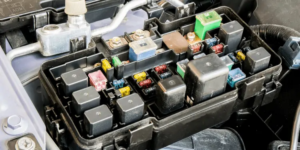In the past, the only way to ensure that your car lights went off when you parked and turned off your car was to double-check before walking away. Then manufacturers fitted an alarm that sounded like the car light switch was still on when you opened the car door.
Sometimes we forgot to check and got a dead battery in the morning, or the alarm didn’t sound to remind us. It was also resulting in a dead battery. A solution was invented.
The Birth of The Auto Light Setting
Many car manufacturers have added a switch for headlights with an auto setting to overcome this problem. When you turn on this feature, it automatically turns on the lights in the dark.
During the day, they don’t turn on, even if the auto-feature is used until the sun starts setting. If you drive through a tunnel where light is not present during the day, the headlights turn on again. But some people worry that this setting may drain the battery when the car is off.
That’s not true,
The sensor/feature turns off as soon as you turn off the car, and during its operation during the daytime, it doesn’t draw much power. The power is consumed only when the headlights are turned on.
Now, let’s understand what type of sensor is used to turn these on and off these lights, and how it works.
What Sensor is Used for Auto Turning of Lights in Cars and How Does It Work?
It is called a photosensor; this sensor detects light.
It is made up of semiconductor material. Whenever light is detected, it changes it into electrical signals. Based on the light intensity, the output of this sensor varies. Its function is similar to a light sensor in your mobile phone, which adjusts brightness automatically.

Now, let’s understand how this sensor is utilized in cars.
Are Headlights On At All Times When Auto is Selected?
The sensor doesn’t sense the light in cars based on your vision. Instead, the light sensor is usually positioned at the top of the windshield – close to the rain sensor that automatically turns the windshield wipers on when it rains – and detects the light intensity around the car.
When the light outside is quite low, i.e., in the nighttime, whenever there is a storm, or when you are in a tunnel, the sensor detects no light outside.
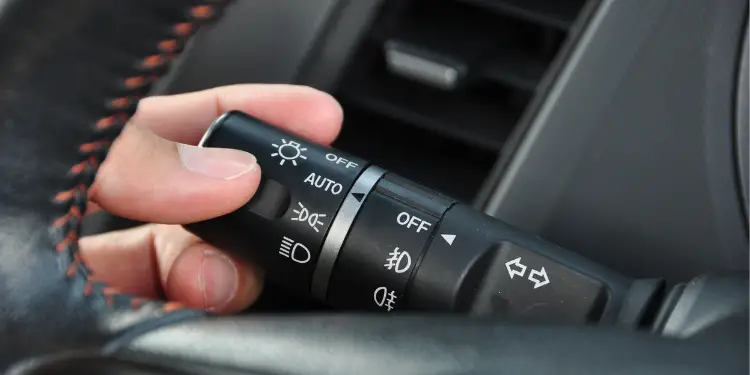
In this situation, with little or no luminous flux, the system is programmed to turn on the headlights.
During the day, when there is sufficient ambient light outside, the sensor changes it into electrical pulses and tells the ECU to turn off the headlights.
Some people think that turning auto mode turns ON their car light permanently when it is on. This isn’t the case; auto lights only turn ON when they sense it is dark outside.
Rarely, you may notice that lights turn during the day, even when there is ample light. This happens whenever your windshield is dirty. In that case, the sensor is blocked and is not receiving proper light. Cleaning the windshield will fix the problem.
The photosensor is very helpful because we don’t have to turn it on and off the headlights manually.
The system automatically turns on the lights when the outside conditions change. Similarly, the system turns off as soon as the car powers off. In addition, you don’t have to worry about battery drainage if you mistakenly leave the headlights on.
Many visitors also read this article: Car Lights Coming On By Themselves At Night [Help and Advice]
What Prevents Cars Electrical Systems From Draining the Battery When The Car Is Off?
Nowadays, modern vehicles come with many electrical accessories and complex electronic circuits. When you turn off the engine, the whole electrical lights turn off.
The electrical systems in a car turn on and off due to the use of relays. All the electrical devices in the cars, be it headlights, interior lights, radio, etc. turn on and off using a relay.
The relay is a switch, in simple terms, an electronically operated switch. It is also known as an electromagnetic switch since it consists of an electromagnet. The main function of a relay is to switch off a high-current circuit using a low-current. You’ll find the relay for the auto headlights in the fusebox under the hood, along with most others.
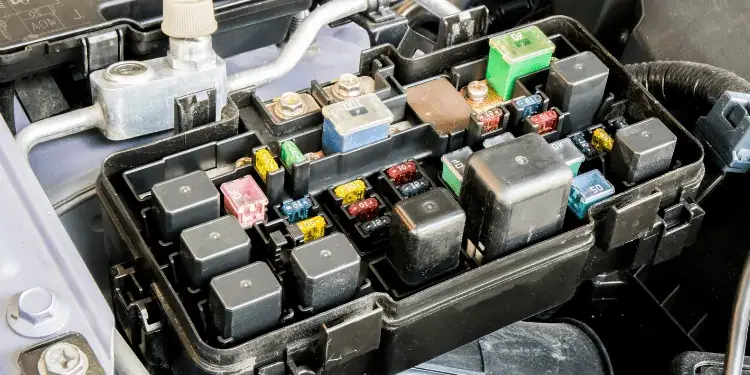
Another function of the relay is to power on and off multiple circuits using a single switch—for instance, the car’s central locking. Using a single button, all the doors can be locked or unlocked.
What Other Systems Should be Turned off at Night that Could Drain the Battery?
Apart from headlights, many systems could drain your battery, such as if interior lights are turned on, the car has a bad relay or alternator, or if the battery’s terminals are loose.
Interior Lights are Left ON
Your battery constantly gets charged whenever you are driving through the alternator. But once the car is turned off, the charging process stops. Now, if your interior dome light mistakenly remains on for the whole night, it can drain the battery. The good news is that on modern cars, this light will come on automatically for 30 seconds as you remove the car key and turn it off when you lock the car.
For people that sit in their car with the engine off for longer periods flicking the dome switch on will keep it illuminated. The problem arises when we forget to turn it back to auto when we’re done.
Electrical Devices Charging
At times, we charge our phones in the car; if mistakenly the phone or any other accessory is left to charge when leaving the car, the battery drains off quickly. Usually, this doesn’t happen as a relay will close the circuit on most cars to prevent it. Most people are still wary and unplug anything electrical to be sure the battery isn’t being drained.
Bad Alternator
As mentioned earlier, the alternator keeps charging the battery when the engine is ON. So, you can turn on lights and charge your phone during the drive. But if the alternator is not functioning properly, the battery doesn’t get charged fully. And that is why it drains quite rapidly.
Sometimes a bad alternator will take charge away from the battery when the car is off. This is called a parasitic draw. It’s called this as the alternator acts as a parasite and drains the life away from the battery.
Many visitors read this article next: Can A Bad Alternator Drain a Battery? And How To Prevent It
Bad Relay
It’s not just the alternator that can take charge away from the battery.
Malfunctioning relays can keep electrical devices ON; the relay gets stuck in the open position. This parasitic draw drains current from the battery without you often realizing it until the battery is weak in the morning and your car won’t start.
Corroded or Loose Battery Terminals
Over time, the battery’s terminals get corroded, and when that happens, you might face trouble starting your car.
Similarly, if the battery terminals are loose, the battery cannot transmit or receive current properly.
This corrosion, called sulfation, is often caused because the battery is overcharging and close to failing.
Many visitors also read these related articles: Why Do Hazard Lights Blink When Car Is Off?
In conclusion
Headlights on the auto setting will not drain your car battery. The only exception is a faulty relay failing to close the electrical circuit, sending current from the battery to the headlight circuit.


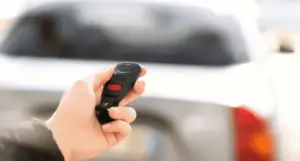
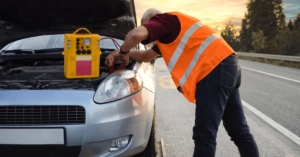

![Car Lights Coming On By Themselves At Night [Help & Advice] car-headlights-on-at-night](https://carzaza.com/wp-content/uploads/2023/12/car-headlights-on-at-night-300x150.png)
